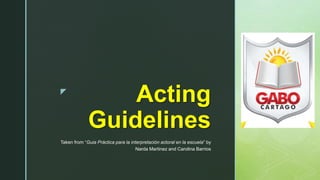
Acting Guidelines.pptx
- 1. z Acting Guidelines Taken from “Guia Práctica para la interpretación actoral en la escuela” by Narda Martinez and Carolina Barrios
- 2. “Instead of thinking outside the box, get rid of the box.” Deepak Chopra
- 3. z Spontaneity, Imagination and Creativity Spontainety is the way of expressing feelings. It is natural. Imagination is the capacity of seeing different ways to deal with a problem. New combinations, new correlations. It is rooted in observation and experience. Creativity is finding the right solution to a problem. It is the faculty of creating of new ideas, objects or procedures by placing them in a specific context or area.
- 4. z Improvisation Each exercise begins with the development of spontaneity and imagination to end with creation. Do not interfere on stage 1. Use your body language. Do not give ideas to other partners. Never say no a to a proposal. Participate actively. Work in teams.
- 5. z Improvisation You gain: Physical resistance Body sensitivity Response capacity Concentration Mental alertness Team Work
- 6. z Memorizing Phrases Phrase Character Action Time Place 1 A shadow moves softly No data No data 2 A shadow stretching its arms No data On an frozen wall 3 A shadow turns around No data The stage
- 7. z Character Building Interesting aspects such as: Attitudes Movements Space management Voice volume Text interpretation
- 8. z Key elements on Character Building We build a character when we deeply know who he / she is. What he thinks. What he feels. How he acts. And… we try to represent him accurately!
- 9. z Personification To be another person. Not to show yourself, it isto represent others before an audience. -Torstov It means to interpret internally and externally a person who owns a different life from ours. The mission it is to build a character in a coherent and interesting way. It means to explore different emotions by approaching a different ambience.
- 10. z Approaching the character POV: Point of View Personality Traits: sad, happy, shy, kind… Physical Features: age, type of body, disability A short biography: where is he/she from?, what happened before that situation?, what kind of life has he/she had, easy/hard…? Draw the character
- 11. z Dialogue Interpreting Motivations Feelings Thoughts of the character Pharse Verb Image But my wife insisted. insisted A woman lecturing
- 12. z Recommendations for your voice volume Do not shout Open your mouth widely while speaking Keep your head vertically, try not to tilt your head up or down. Control and correct body tensions.
- 13. z External characterization It is the creation of the physical structure of the character, by taking into account these physical elements such as: - The hair - The eyes - The way of walking - The way of speaking - The way he sits - How he grabs objects - The type of gaze - His mouth shape
- 14. z Makeup and Costume Think of things you may bring to make up your character, such as Beards Wigs Scarfs Glasses Use the mirror. Draw your character.
- 15. z Reflect on… Each movement and action of your character. What is the character thinking? What does he want to get? How is he feeling? Do not give reasons. Just show it.
- 16. z Scenography Transform the stage by using real objects. Use your creativity to transform objects with other objects. Remember the entrace and exit of the character, (left / right / front / back) Be aware of the space you will have and the time. Use lights, music, background sounds, live instruments. “The preparation of the decoration helps develop imagination” L. Vigotsky
- 17. z 1. Classwork: September 20th-22nd. With a partner you feel comfortable to work with, plan your conversation first, in Spanish by exploring ideas. 1. Characters (Bully / VJJ Learner) 2. Plot: Description of the conflicto 3. Dialogue: Usage of the three steps for Verbal Jiu-Jitsu: 1. Agreeing 2. Acknowledging (Smart questions 3. Turn around (creativity, good sense of humor, compliment)
- 18. z 2. Homework: September 25-29 Once you have submitted your planning to the teacher, start adapting the text into English. Pay full attention to the dialogue by using the language learned during the previous lessons. 1. Dialogue: Usage of the three steps for Verbal Jiu-Jitsu: 1. Agreeing 2. Acknowledging (Smart questions 3. Turn around (creativity, good sense of humor, compliment)
- 19. z 3. Rehearsals: September 25-29th, 2023 Start practicing your dialogue. 1. Build your character by drawing it and looking at yourself at the mirror. 2. Improvise with your partner the dialogue before memorizing it. 3. Apply the strategies of memorization seen during this lesson. 4. Rehearse several times paying attention to the artifacts, scenography and other resources at hand. 4. Video Crafting: October 2nd-5th, 2023
